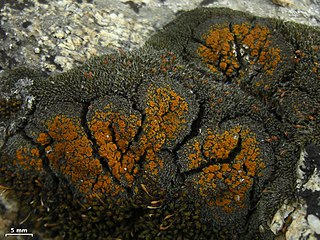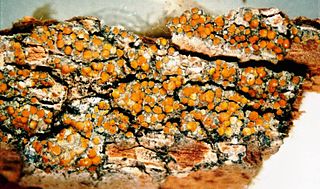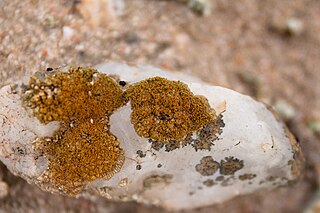
Gyalolechia is a genus of lichen-forming fungi belonging to the family Teloschistaceae. It contains 18 species of crustose lichens.
Austroplaca is a genus of lichen-forming fungi in the family Teloschistaceae. It has 10 species. The genus was circumscribed in 2013 by Ulrik Søchting, Patrik Frödén, and Ulf Arup, with Austroplaca ambitiosa assigned as the type species.

Athallia is a genus of lichen-forming fungi in the family Teloschistaceae. It was circumscribed in 2013 by Ulf Arup, Patrik Frödén, and Ulrik Søchting, and the type species is Athallia holocarpa. The genus name means "without a thallus".

Calogaya is a genus of lichen-forming fungi belonging to the family Teloschistaceae. It has 19 species. The genus was circumscribed in 2013 by Ulf Arup, Ulrik Søchting, and Patrik Frödén. The generic name Calogaya honours Dr. Ester Gaya, a Spanish botanist from the University of Barcelona.

Flavoplaca is a genus of crust-like or scaly lichens in the family Teloschistaceae. It has 28 species with a mostly Northern Hemisphere distribution.

Xanthocarpia is a genus of mostly crustose lichens in the family Teloschistaceae. It has 12 species with a largely Northern Hemisphere distribution.

Parvoplaca is a genus of lichen-forming fungi in the family Teloschistaceae. The genus was circumscribed in 2013 by Ulrik Søchting, Patrik Frödén, and Ulf Arup.

Squamulea is a genus of lichen-forming fungi in the family Teloschistaceae. It has 15 species. The genus was circumscribed in 2013 by Ulf Arup, Ulrik Søchting, and Patrik Frödén, with Squamulea subsoluta assigned as the type species. Five species were included in the original account of the genus. The genus name alludes to the squamulose growth form of most of its species. Squamulea has a worldwide distribution; when the genus was originally created, the centre of distribution was thought to be in southwestern North America.

Cerothallia is a genus of crustose lichens in the family Teloschistaceae. It has four species, all of which occur in the Southern Hemisphere. The genus was circumscribed in 2013 by Ulf Arup, Patrik Frödén, and Ulrik Søchting, with Cerothallia luteoalba assigned as the type species. The type is more widely distributed, as it is also found in Europe and North America. The generic name Cerothallia means "with waxy thallus".
Sirenophila is a genus of crustose lichens in the subfamily Teloschistoideae of the family Teloschistaceae. It has four species with an Australasian distribution.
Villophora is a genus of lichen-forming fungi in the subfamily Teloschistoideae of the family Teloschistaceae. It has 9 species. The genus was circumscribed in 2013 by Ulrik Søchting, Ulf Arup, and Patrik Frödén. They assigned Villophora isidioclada as the type, and at that time, only species in the genus. This lichen, previously classified in Caloplaca, is found in South America, Antarctica, and some subantarctic islands. Several additional species were added to the genus in 2021. The generic name Villophora means "carrying filaments".

Wetmoreana is a genus of lichen-forming fungi in the family Teloschistaceae. It has two crustose, saxicolous (rock-dwelling) species.
Teloschistopsis is a genus of lichen-forming fungi in the family Teloschistaceae. It has three species.
Follmannia is a genus of lichen-forming fungi in the family Teloschistaceae. It has three species. All three species are crustose lichens, and all occur in South America.
Haloplaca is a genus of lichen-forming fungi in the subfamily Teloschistaceae of the family Teloschistaceae. It contains three species of crustose lichens. The genus was circumscribed by Ulf Arup and colleagues in 2013, with Haloplaca britannica assigned as the type species. The genus name alludes to the preference of its species for salt-rich environments. All three species occur in the United Kingdom, but H. suaedae also occurs in Greece, Morocco and Turkey. Haloplaca species occur near the sea, either on rocks or on plant debris.
Gondwania is a genus of lichen-forming fungi in the subfamily Xanthorioideae of the family Teloschistaceae. It has five species.

Stellarangia namibensis is a species of saxicolous (rock-dwelling), crustose lichen in the family Teloschistaceae. It was first formally described in 1988 by Ingvar Kärnefelt, as a member of the genus Caloplaca. The type specimen was collected by the author from the gravel flats east of Cape Cross, in Omaruru, Namibia. The same species was collected from Angola by Austrian botanist Friedrich Welwitsch in 1859. The taxon was transferred to the genus Stellarangia in 2013 by Ulrik Søchting and colleagues, as part of a molecular phylogenetics-based restructuring of the Teloschistaceae.
Orientophila is a genus of lichen-forming fungi in the family Teloschistaceae. It has 15 species of mostly saxicolous (rock-dwelling), crustose lichens. All Orientophila species occur in Northeast Asia including China, Japan, South Korea, and the Russian Far East.
Usnochroma is a genus of lichen-forming fungi in the family Teloschistaceae. It has two species of crustose lichens. The genus was circumscribed in 2013 by lichenologists Ulrik Søchting, Ulf Arup, and Patrik Frödén, with Usnochroma carphineum assigned as the type species. The genus name refers to the yellowish-green colour of the thallus, which is caused by the substance usnic acid. Usnochroma species occur in Macaronesia, South Africa, the Mediterranean Basin, and Algeria.
Scutaria is a single-species fungal genus in the family Teloschistaceae. It contains the species Scutaria andina, found in South America. The thallus of this lichen has a form that is intermediate between crustose and foliose.










